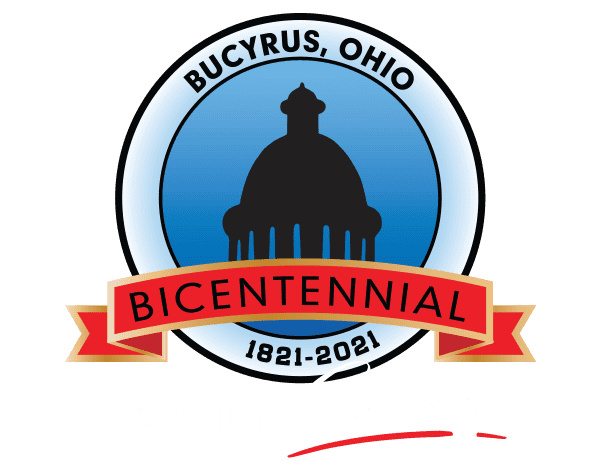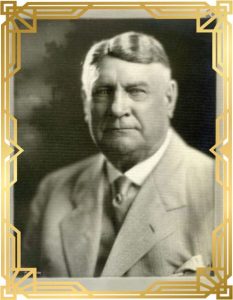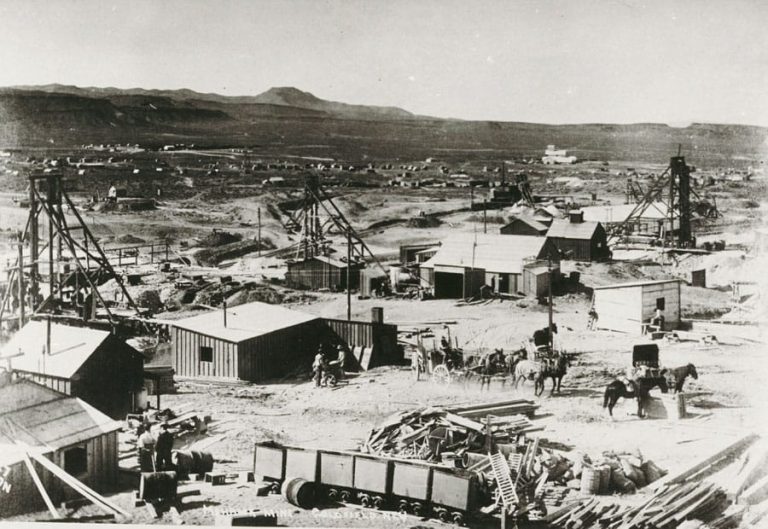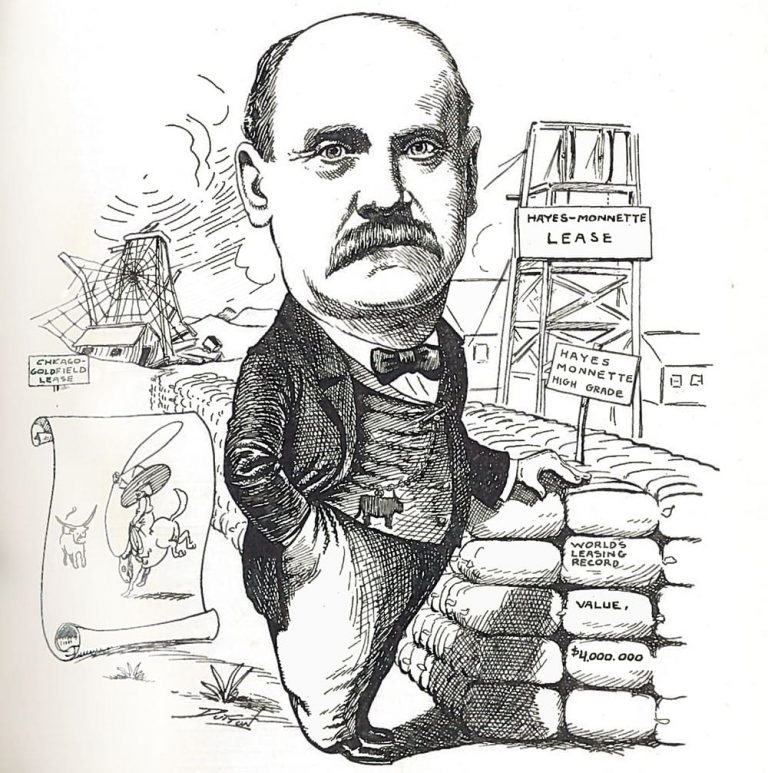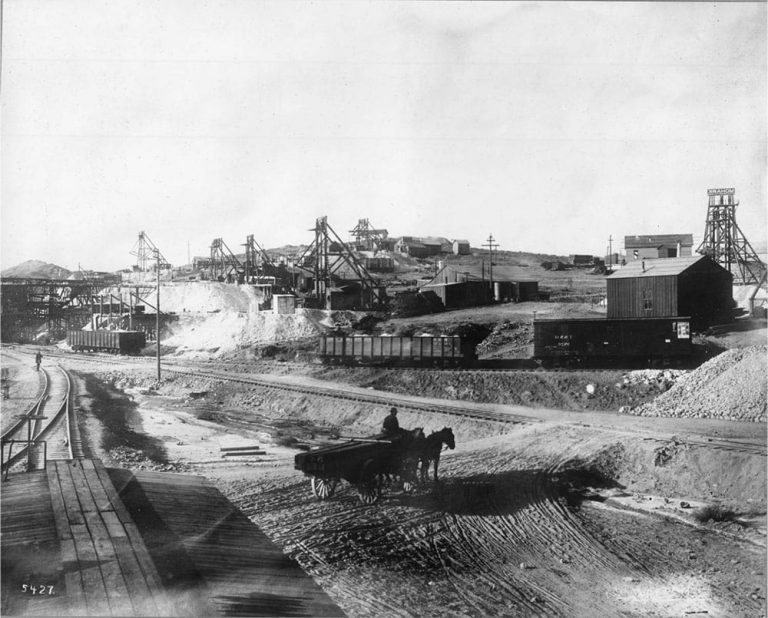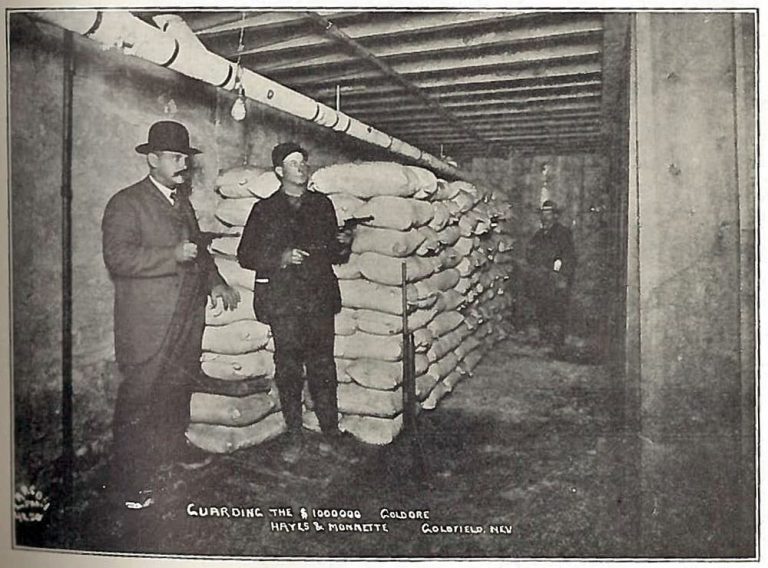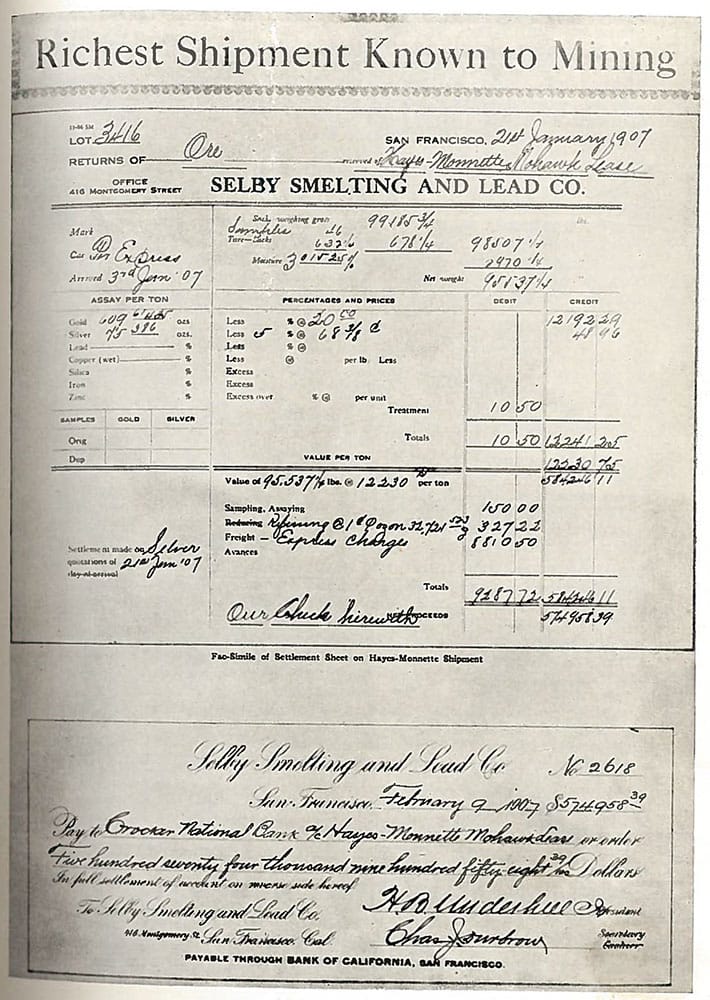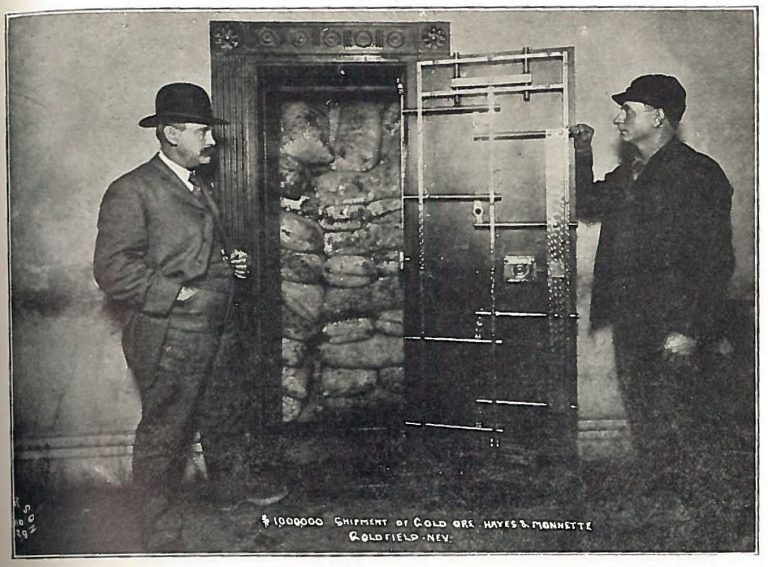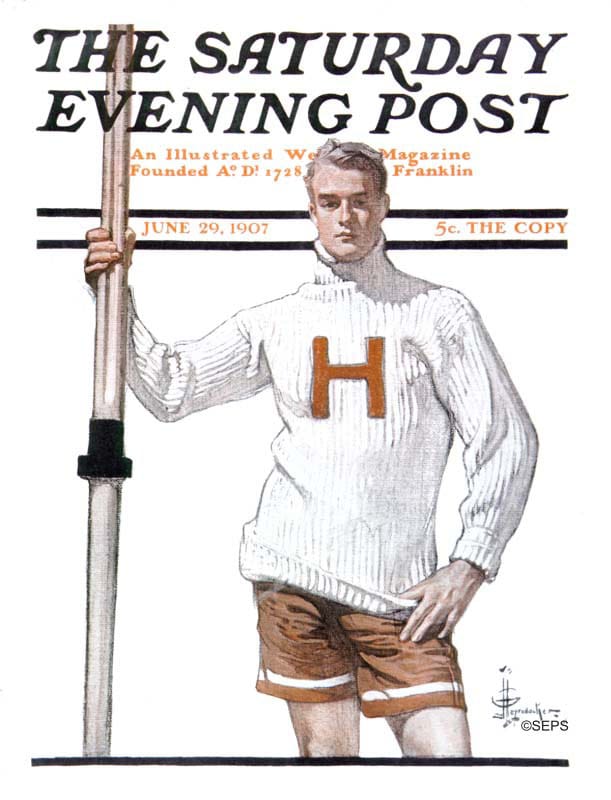The Monnettes
A Golden Opportunity
Out West
In 1897, Mervin and Olive moved out of Bucyrus to pursue new opportunities and with the hope of finding a way to recover from their financial downturn.
The couple eventually settled in Colorado Springs, Colorado. During 1897 and 1898, Mervin became involved with several successful mining enterprises.
In 1898, Mervin and Olive acquired several hundred acres of land in the state of Nebraska (Central City and Omaha). At this time, Mervin returned to his cattle ranching days, as he also owned and operated (for himself and Mr. T.B. Hord) several large stock ranches. Mervin also served as a stock dealer at the stockyards.
After reaching great success with his ranching pursuits, Mervin and Olive eventually achieved financial recovery. However, Mervin–never one to rest on his laurels–then undertook several mining ventures. In 1904, a claim of his at Tonopah, Nevada, yielded a significant gold strike–enough to allow Mervin to return to Bucyrus and pay his debtors.
The strike also yielded enough money for Mervin and Olive to live in the manner in which they were once accustomed. Mervin went on to pursue another mining venture, in Goldfield, Nevada.
By 1905, Mervin urgently encouraged and enlisted his son Orra, to also become involved with his mining venture in Goldfield, Nevada. Mervin had been tasked by some business acquaintances to help investigate an abortive mining camp.
The investigation of an abortive mining camp came about because some of Mervin’s Chicago business colleagues had taken on a mining claim as a payoff from a debt. These colleagues were hesitant to trust the so-called “experts” on mining properties, fearing they were being duped.
However, knowing Mervin Monnette to be extremely ethical, these friends relied on Mervin to give them an honest reporting. This was despite the fact that Mervin himself lacked any real significant mining knowledge.
Specifically, they asked him to make a trip on their behalf to investigate whether they should take make the difficult trip to the Nevada deserts– an area then considered rugged and unknown.
Ultimately, Mervin decided to make the hazardous trip to Nevada.
And this trip proved to be the “golden” opportunity of a lifetime for the Monnettes.
Goldfield, Nevada
Today, it’s difficult to fully comprehend the daunting conditions experienced by gold seekers back in 1905–in terms of both the dangers and the extreme isolation.
Goldfield then lacked railroad communication and was literally two-hundred miles from nowhere. Without either timber or suitable stone, the “houses” were tents made from cloth or canvas. Some houses were simply dugouts or holes in the ground.
At the time, Mervin Monnette was almost sixty years-old. This was a dangerous undertaking for anyone unused to these hardships—let alone someone his age. Nonetheless, Mervin was again undeterred and suddenly became a gold seeker. In the summer of 1905, he set out for Goldfield, Nevada.
Mervin soon reported to his Chicago colleagues and clients that their mine had already been “salted,” which saved them a considerable amount of additional expenses. However, not too long after making the report back to his acquaintances, their mine ultimately proved to be non-prolific.
However, stories of alleged gold discoveries were frequent and widespread throughout the general area. Lured by these tales, Mervin decided to remain in Goldfield a bit longer. He wanted to investigate further and see if anything good would personally come his way.
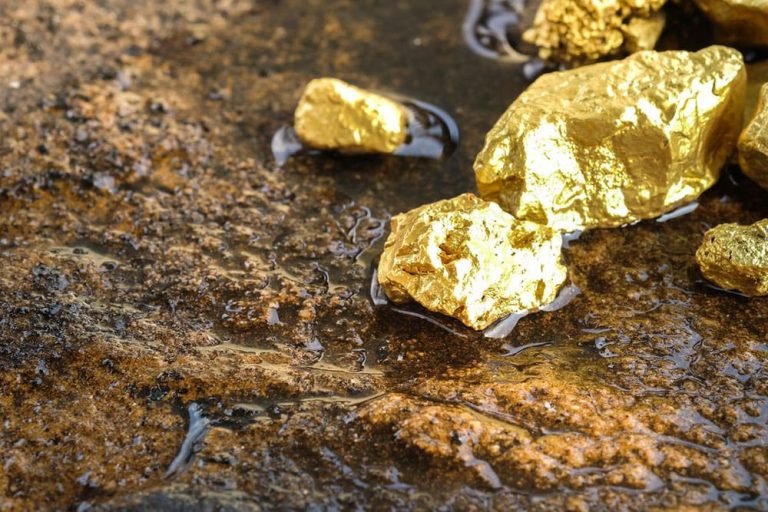
Mervin soon met Mr. Granville H. Hayes, a graduate of the University of California. Also a man of “mature” years, Mr. Hayes had been a miner for several years and had already made and lost two fortunes.
Mr. Hayes was knowledgeable and experienced in practical applications, but he lacked the necessary capital to proceed.
Hayes also strongly believed certain idle and/or abandoned claims (then owned by the Goldfield Mining Company) possessed tremendous possibilities. At this point, Monnette and Hayes formed a partnership, and Mr. Hayes procured a mining lease upon some property.
This mining lease was executed between these two parties September 1, 1905.
The property covered by the lease had already been mined by two separate parties, and $40,000.00 to no avail. Specifically, a shaft 80 -feet deep had been sunk, cross-cutting and trenching 400 feet.
After that ground was thoroughly assessed it was deemed an unalluring prospect and essentially reduced to a dry hole.
However, Mr. Hayes was undeterred and took some assays (ie. the testing of a metal or ore to determine its ingredients and quality) of the refuse of former workings. Hayes insisted the assays showed or indicated bodies of ore somewhere on the property.
But without finances he was at a standstill. That’s when Hayes appealed to Mervin Monnette.
Monnette advanced about $10,000.00 for machinery and supplies. Work was undertaken in earnest–with slim hope of success since others had already previously failed.
It was soon evident that not enough money was available to accomplish anything of significance, so Mr. J.W. Smith and Mr. Harry Benedict of Chicago also advanced their proportion of necessary funds.
In October 1905, they became joint lessees with G.H. Hayes and Mervin Jeremiah Monnette. Smith and Benedict shortly thereafter returned to Chicago and did not actively participate in the mining.
The hands-on work was instead carried on by Monnette and Hayes. As a result, in Goldfield (and universally) it ultimately became known as the “Hayes-Monnette Lease” on the Mohawk Gold Mine.
Both Granville Hayes and Mervin Monnette not only managed the property, they also sometimes did manual labor. It was extremely hard work and often quite discouraging.
However, that outlook made a major turn in a positive direction by April 1906. A significant “strike” was made, and the dreams of the fortune-seekers soon became a golden reality.
Mervin Monnette and his partners are credited with opening up and developing both the largest–in both extent and value–the richest gold mine up until that time.
In 1906-1907, this strike was the richest discovery ever known in the history of the world.
Madmen of the Desert
In 1907 Mr. Rex Beach, a writer, made a visit to Tonopah and Goldfield, Nevada, at the request of the Saturday Evening Post.
He later wrote an account of his observations, in a series of articles, entitled, “The Madmen of the Desert” In it he stated:
“I had heard the story of the Hayes-Monnette Lease, of how four men in four months made four million dollars out of an acre and a half of ground on the Mohawk, yet every Nevadian to whom I talked passed me this as a fresh bit of news. I asked of other doings, but they forced this tale at me again and again. I turned my face away and demanded details of other mines, only to receive the Hayes-Monnette story in a new guise, like the Hank Monk & Horace Greely episode. “
From another newspaper during that time:
“Imagine two partners working for months on a piece of ground with no results, sinking meantime their last cent, then suddenly into a chamber of solid ore containing wealth enough to realize the dreams of Croesus. Such, in brief, is the story of the successful fight for riches made by two deserving men, G.H. Hayes and M.J. Monnette, the latter having been attracted from the comparative quiet of an Ohio city to the desert by the lure of gold.
Mervin Monnette, who met Hayes after reaching the West, put up the money, all that he had been able to get together 'back home.' Hayes furnished the practical experience, being an expert miner of years’ standing, and as their great find was made on ground with no ledge or surface indication to suggest what might be below,. There is but very little question that the uncovering of their treasure house was directly traceable to Hayes’ disciplined mining sense, which prepared him to realize the possible value of the ground.”
